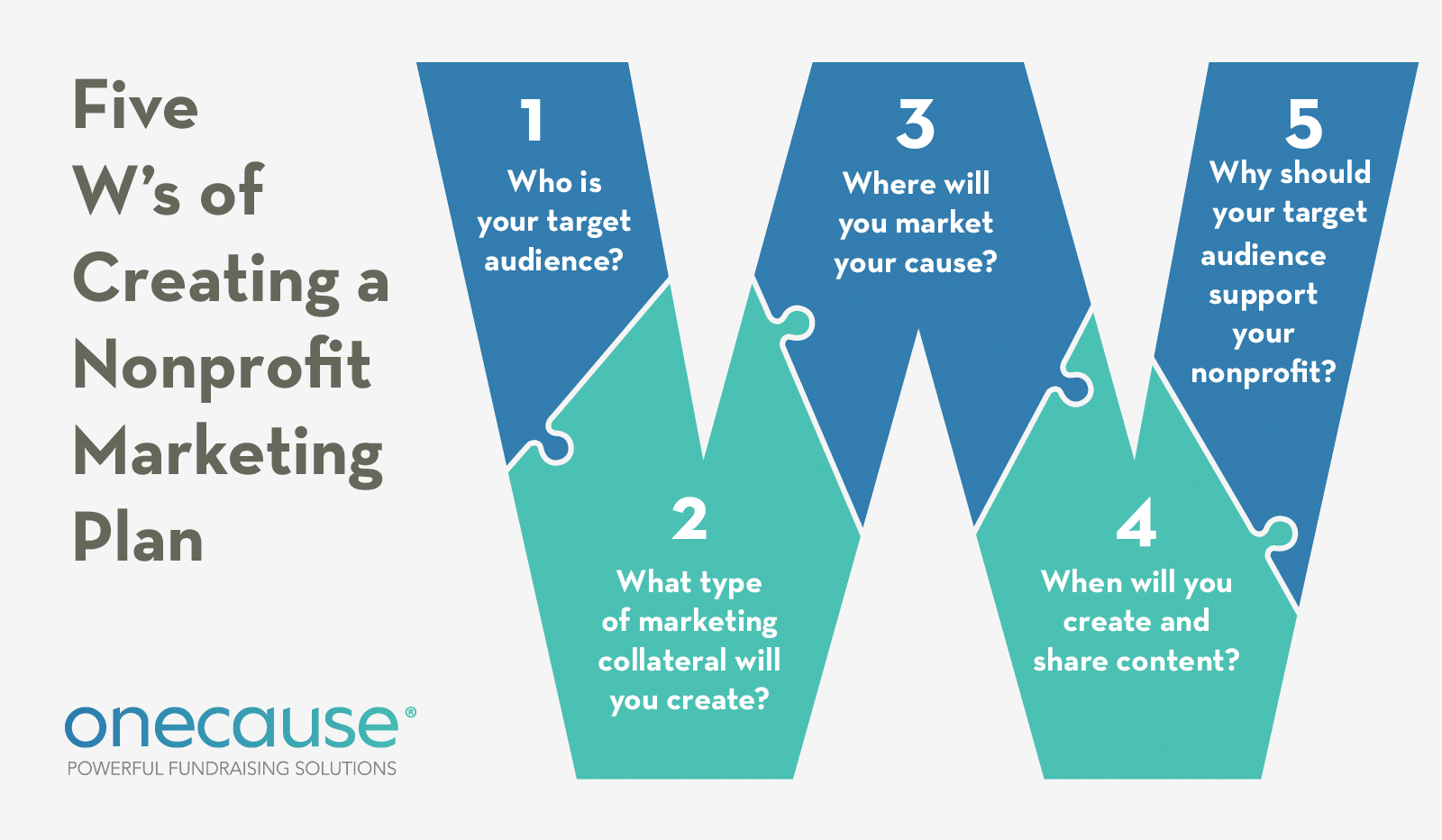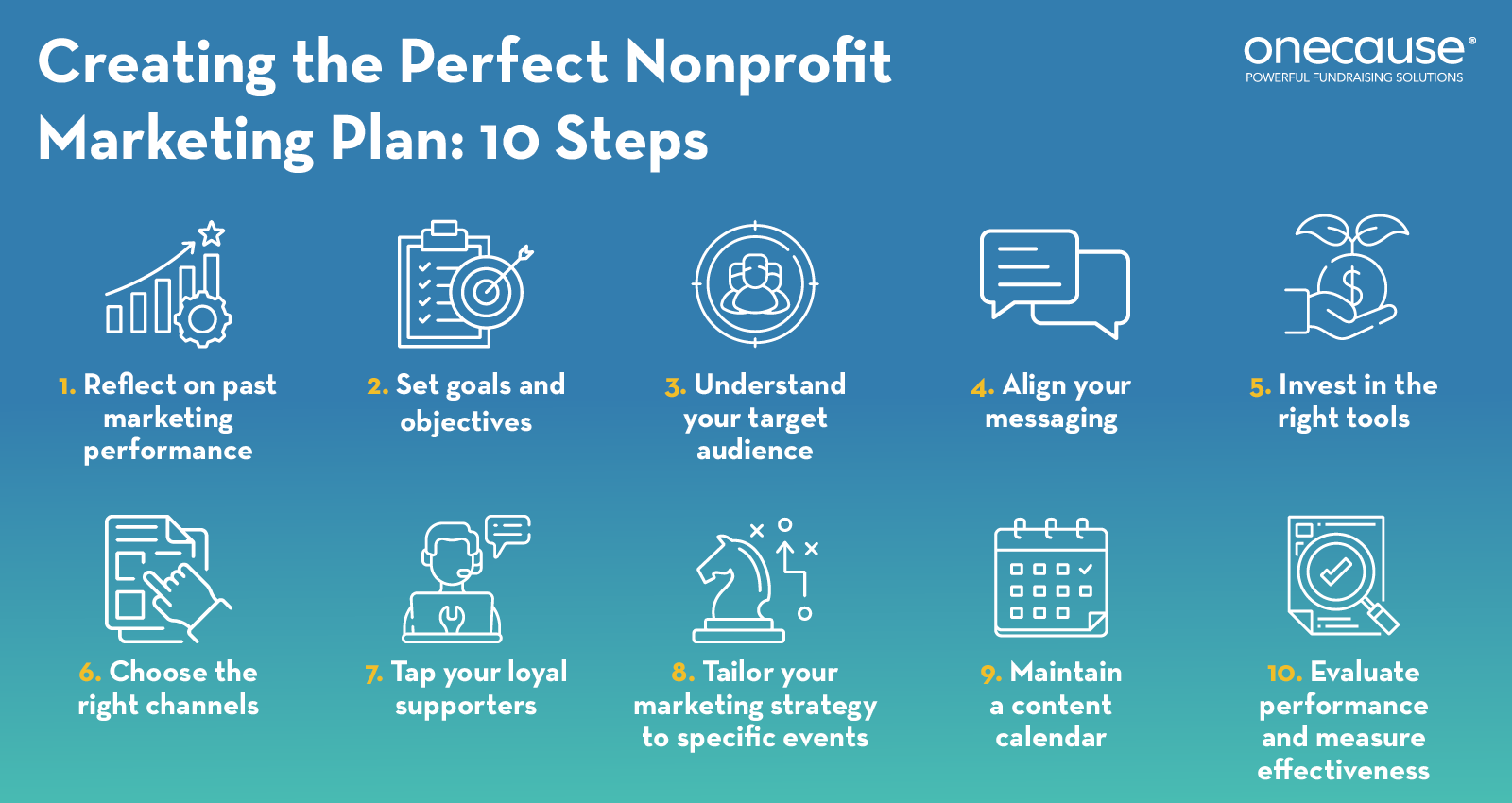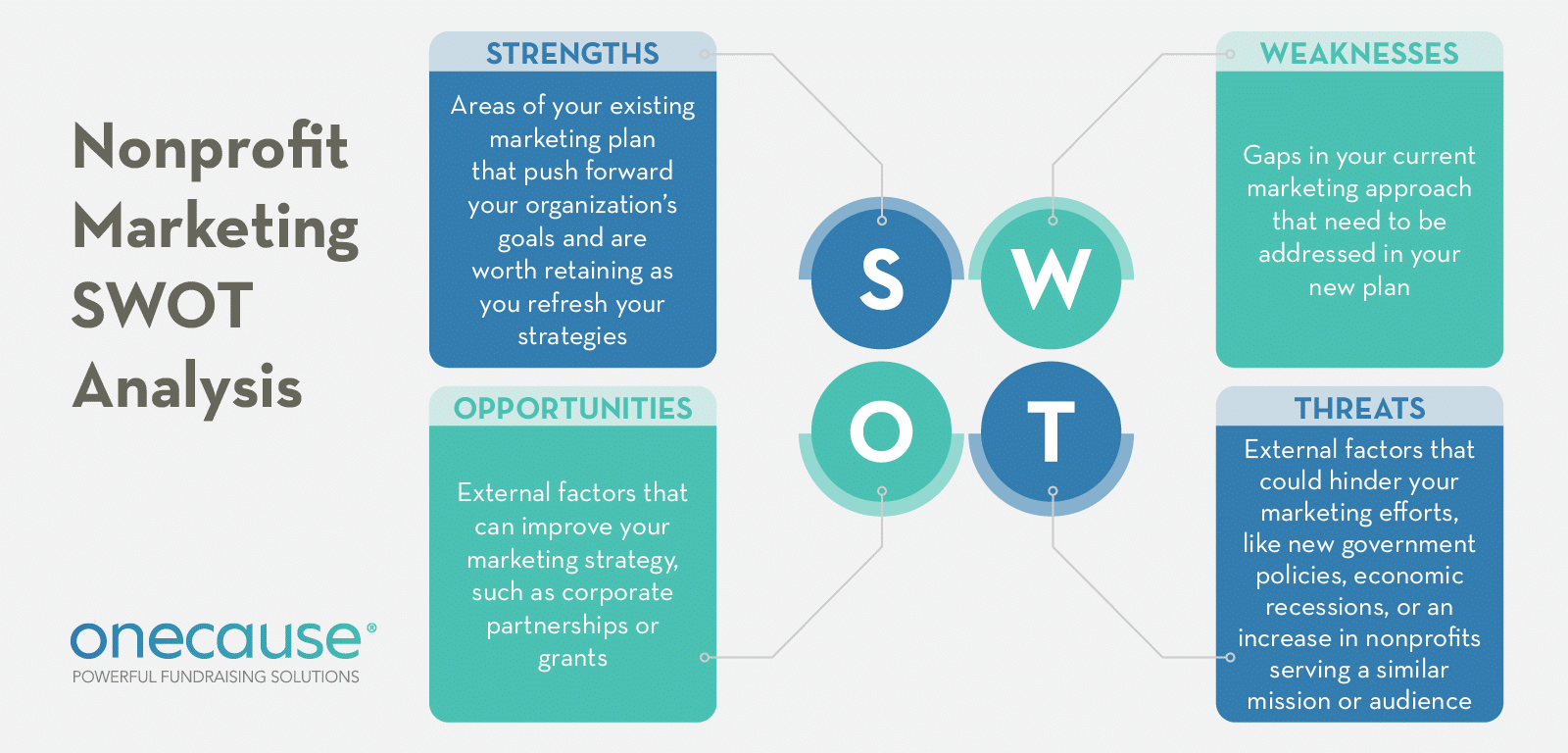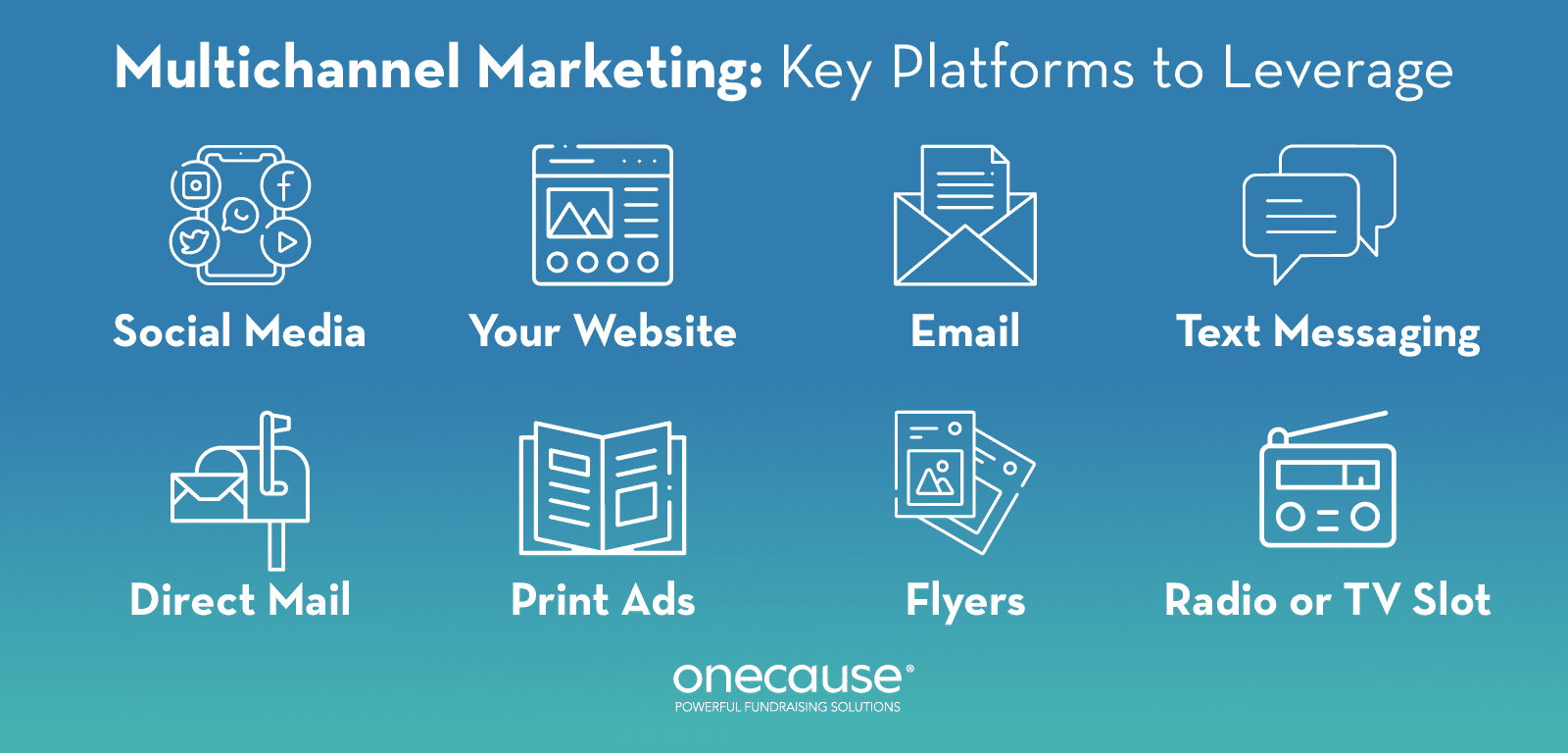
Getting the word out about your nonprofit’s services, campaigns, and events is critical to your mission’s success. With so many resources at your fingertips—from digital platforms like social media to more traditional advertising opportunities like direct mail—your organization has several options to communicate your mission and build support for your cause.
However, creating a strong marketing plan isn’t based on the quantity of how many platforms you use or the number of promotional messages you share; instead, it’s the quality of your marketing approach that counts and ultimately determines your nonprofit’s success in amplifying its cause and growing a loyal donor base.
This is where taking the time to compose a strategic marketing plan can help. A marketing plan gives your nonprofit a clear framework for describing your mission, establishing your brand, and effectively reaching your target audience. With these guidelines, you can confidently approach any marketing campaign or fundraising event and expand your reach to supporters near and far.
In this guide, we’ll walk you through all the essentials you’ll need to create a marketing plan tailored to your nonprofit. We’ll cover:
Your nonprofit puts in a lot of hard work to bring its mission to life. Now, you just need the right marketing strategies and tools to connect donors to your cause and boost your support. Let’s begin!

Before we dive into how to create the perfect nonprofit marketing plan, let’s make sure we cover the basics. These common FAQs can help you understand how to construct a powerful marketing strategy.
A nonprofit marketing plan outlines how your organization can bring attention to its cause, campaigns, and events with target donor segments, using various marketing channels. These guidelines will help your nonprofit through every step of its marketing approach, answering questions like:

Creating a nonprofit marketing plan is a great opportunity for your entire team to reflect on your current marketing approach and how you can hone your strategy for increased engagement.
Once you compose your nonprofit marketing plan, your staff members and volunteers will have a trusted framework to guide their marketing and communication tactics. This ensures that all of your marketing activities are aligned and promote the same messaging and goals.
Creating a marketing plan for your nonprofit requires time and thoughtful consideration, but the benefits are well worth the effort. A cohesive marketing plan can:
Think of your nonprofit marketing plan as a roadmap for all communications. A thorough plan will give your team the clarity and organization needed to lead any marketing campaign on any channel and produce outstanding engagement results. Revisiting your plan once a year makes it easier for your team to make necessary adjustments, ensuring the document serves as your sole source of truth for communicating your brand and mission.
With a well-crafted marketing plan, your nonprofit is well-equipped to achieve its goals and make a lasting impact.
A detailed nonprofit marketing plan is the cornerstone of successful outreach, enabling you to effectively promote your events, campaigns, volunteer programs, and more. Here’s how to ensure your plan covers all the bases:
Focus on your organization’s goals and target audience as you map out each component of your plan. Investing time now to create a cohesive marketing plan will pay off in the long run, so collaborate with your team to craft a winning strategy that makes sense for your nonprofit.

To create the strongest marketing results for your organization, you need to consider how to best use the team members, tools, and resources at your disposal to optimize your outreach. Follow these steps to construct the perfect marketing plan for attracting more attention and supporters to your mission.

Your nonprofit may already have a marketing strategy in place, but is it producing results? Conduct a SWOT analysis to identify what’s working and what’s not. A SWOT analysis allows your organization to outline its strengths, weaknesses, opportunities, and threats.
Let’s break down what a marketing SWOT analysis looks like:

Gather insights and opinions from a variety of stakeholders to determine how your marketing plan can improve. Your stakeholders might include:
Don’t just reach out to stakeholders that think highly of your organization. Critiques are invaluable, as these will point your organization in the direction of optimizing its approach. It’s important to be open to both positive and negative reviews to help your nonprofit’s marketing strategy become more effective.
Now that you’ve conducted a marketing audit and identified areas for improvement, it’s time to set concrete goals for your marketing strategy. Establishing clear, ambitious goals will enable your organization to grow and thrive over time.
However, it’s not enough to set broad goals like “We want to expand our social media presence” or “We’ll work on developing better event landing pages.” The more detailed you are in the goal-setting process, the more effective your organization will be in driving positive change.
This is where the SMART model comes into play. SMART goals are Specific, Measurable, Attainable, Relevant, and Time-bound, giving your organization a complete roadmap to how you’ll meet these goals and assess results.
Let’s say your nonprofit wants to improve its email marketing strategy. From your SWOT analysis, you found that your click-through rates are low and you’re sending out emails too erratically to inspire conversions.
Here’s how you could create a SMART goal to strengthen your email marketing:
Your fundraising events are a powerful source of revenue and help build community for your cause. If people don’t show up, you’re missing out on valuable face time with donors, volunteers, corporate sponsors, and other community members.
Here’s how you might set a SMART goal for event attendance that ensures your promotional efforts are targeted and effective:
Takeaway: Following the SMART framework ensures you’re generating goals that are relevant to your marketing strategy and will expand your reach. You can also use them to foster accountability across your team, so identify the relevant people for each goal and ensure they’re aware of the timeline and success measurements.
One of the best ways to nail down the details of your target audience is by developing a supporter persona. A supporter persona is a fictitious profile that outlines characteristics that are typical of your real-life supporters.
To craft a supporter persona, consider the following details:
To develop your supporter persona, base these details off of a few real-life supporters. Ideally, you should create separate personas for your donors, volunteers, and other contributors. This way, you can adjust your messaging based on who you’re attempting to reach.
For example, if your organization is hosting a food drive, you’ll need to reach donors to help fund the cost of canned foods and give them to your organization as well as volunteers to help organize the cans and hand them out to individuals in need.
Once you know the different groups you’re targeting, you can send separate communications using segmentation features. You can even segment your email contacts list into different subgroups and tailor messages to the specific subsets of your audience.
Your messaging across different channels, from social media and email to your blog content, should be consistent. If the way you describe or visually portray your nonprofit changes from platform to platform, this can easily confuse supporters and lead to a decrease in trust. When shaping your messaging, it’s important to consider both your verbal and visual branding.

Verbal branding is critical to building a strong relationship with your target audience. With your team, answer the following questions to inform your marketing communications:
It’s equally important to consider not only what you say, but how you say it. Your organization might want to adopt a casual, friendly tone to relate to a younger audience. Or, a serious, professional tone might be more appropriate to set your organization across as a trusted thought leader. Think through which type of tone is more likely to resonate with your target audience and makes the most sense based on your mission.
Visual branding complements your verbal branding to make your messaging more lively and exciting to engage with. By creating a strong visual identity, supporters will immediately recognize that your content belongs to your organization.
Infuse the following elements into your marketing materials:
By adding your visual and verbal branding elements into your marketing communications, you’ll strengthen your nonprofit’s online presence, increase your visibility, and connect with new and existing supporters.
The right technology can streamline your marketing efforts, saving your organization time and making it easier than ever to market your campaigns, events, and other activities. Invest in the following tools to reduce your team’s administrative burden and hone your marketing strategy:
Your fundraising and marketing strategy should work in tandem to promote your success. Leverage an all-in-one fundraising platform that has everything you need to market events and hit your fundraising goals out of the park. These features should include:
The right fundraising platform will fuel your organization’s fundraising and communication strategies for any event, whether you’re hosting an auction, gala, or peer-to-peer fundraiser. Do your research to find the perfect solution to meet your nonprofit’s unique needs.
Social media is one of the best resources at nonprofits’ disposal to expand their reach. However, organizing your content and engagement tactics on multiple platforms can quickly eat up your time and overwhelm your staff and volunteers. To support your social media content strategy, work with social media management software.
Social media management software can help your nonprofit:
Before, during, and after your campaigns and events, post engaging social content with the help of a software solution that will unify your social strategy and engage donors.
Constituent relationship management software (CRM) organizes all of your donor data in one place so you can develop comprehensive donor profiles, track donor behaviors, and personalize your interactions to prompt donors to give more frequently (and in larger amounts).
Throughout your different marketing campaigns, leverage your CRM to segment your supporters and tailor your communications to different subgroups. Highly relevant donation appeals and messages are more likely to lead to conversions, allowing you to meet your goals. You can also use your CRM to collect data insights and use these to reframe your marketing and fundraising approach in the future.
A content management system (CMS) can help your nonprofit improve its main website and turn it into a powerful marketing tool—allowing you to attract new supporters to your cause and engage existing supporters. Work with a comprehensive CMS to:
There are many free CMS solutions available, but not all are user-friendly to nonprofits that are new to web design. Look for a website builder that meets your level of expertise and will support you throughout the web design process.

As you build out your marketing strategy, it’s important to diversify your channels in order to reach as many supporters as possible. Consider generating engaging content on the following platforms:

Social media channels, like Instagram, Facebook, and TikTok, are perfect for keeping supporters up to date on your latest activities and attracting new people to your mission. After all, 32% of donors are most inspired to give via social media, followed closely by email (30%).
As an added bonus, the shareability of posts makes social media content a prime channel for peer-to-peer initiatives. Using the supporter persona you generated earlier, determine which social media platforms your target audience is most likely to see your content on. Then, focus your efforts on platforms that are likely to bring more eyes to your nonprofit.
Make sure to frame the content to the specific platform you’re posting on. For example, Instagram is ideal for photo and video content, Facebook is great for longer-form text content and multimedia visuals, and TikTok is well-known for generating short video clips.
Your website is the foundation of your nonprofit’s digital presence. If you don’t already have a nonprofit website or your existing one needs a tune-up, developing a user-friendly and appealing website will support your marketing efforts.
Your website serves as the central hub for all your online activities, providing essential information and engaging content for your audience, so make sure it’s equipped with everything a potential supporter or beneficiary needs to know about your mission. Pay special attention to the following pages:
To boost your website’s reach, you’ll need to implement a robust SEO strategy for your nonprofit. SEO involves optimizing your website content to rank higher on search engine results pages (SERPs), making it easier for potential supporters and beneficiaries to find you.
Here are some key elements of an effective SEO strategy:

Developing a comprehensive SEO strategy takes time and effort, but the long-term benefits of increased traffic and sales are well worth it. Consistently monitoring and refining your approach will help ensure your nonprofit’s mission, purchasable services, and products are easily discoverable by those who can benefit from them most.
Another powerful way to amplify your nonprofit website is through digital advertising. By strategically using online ads, you’ll reach a larger audience and drive targeted traffic to your website.
Consider the following digital advertising strategies:
Compared to other platforms, search ads have the highest return, coming in at $2.70 for every dollar spent. However, it’s all about choosing the platforms your supporters and beneficiaries use the most. By understanding where your audience spends their time online, you can allocate your advertising budget more effectively and maximize your reach.
Email marketing is a great way to reach your supporters more directly with highly tailored messages. To expand your email marketing strategy, consider these best practices:
If you’re getting ready for a large-scale event, make sure to begin emailing about it at least two months in advance. Each email should consist of exciting details supporters can look forward to, such as providing sneak peeks of your auction items or revealing the theme of your fundraising gala.
Text messaging puts your communications right in front of supporters, helping to create a more authentic one-on-one communication experience. Encourage donors to subscribe to your text messaging campaigns on your website, social media, and in your email newsletters. As you build up your contact list, you can text supporters:
You can also leverage a text-to-give tool to make it easy for donors to give right from their mobile devices as soon as they’re inspired by your marketing messages. Text-to-give can help you raise money before your upcoming event and even supplement your fundraising goals year-round to increase your annual fundraising.
Traditional advertising is also a valuable way for nonprofits to reach supporters. Print marketing gives an added personal touch to your communications and helps to build trust. Popular traditional advertising channels include:
You can also save your print marketing strategy for high-value supporters. For example, if you’re hosting a hybrid auction, you might market the remote portion of your auction online for all of your supporters, but then send handwritten notes to your major donors inviting them to an intimate in-person auction experience.
To re-energize your marketing and expand your reach across a wider donor network, tap ambassadors to help out. Ambassadors are the social butterflies of the fundraising world; their large social networks, influence, and outgoing nature makes them the perfect helping hands to spark some energy and creativity into your marketing campaigns.
Individuals that would be a good fit for your ambassador marketing campaign include your:
Make sure to set your ambassadors up for marketing success by providing them with training materials and your verbal and visual branding guidelines. This way, they can effectively communicate your mission to others online and in-person and build support for your cause. Plus, consider infusing healthy competition into your ambassador campaigns by creating fun contests based on who can get the most donations or event registrations.
Event marketing is the secret sauce to pulling off an unforgettable fundraiser. However, your strategies will likely look different depending on the event your organization is hosting. For example, if you’re hosting a walk-a-thon with a peer-to-peer fundraising component, you’ll want to put a heavy emphasis on social media outreach. This way, you can tap into vast networks of current and potential donors and encourage them to start their own fundraising campaigns (and share them widely with engaging hashtags and content!)
On the other hand, let’s say your organization is hosting a golf tournament. These leisurely, high-grossing events are a great opportunity to connect with major donors (and prospective major donors) and encourage them to give a significant contribution. To target your major donors, you might make your marketing approach more personal by focusing on direct mail outreach.
Consider the target audience for your events and where it would make the most sense to reach them. Then, once you’ve nailed down the right approach, be sure to infuse storytelling into your communications to pull at supporters’ heartstrings and motivate them to register or give.
Continuing with the example of a golf tournament, a healthcare organization might share a story with prospective major donors about a child who is awaiting surgery and desperately needs financial support. This emotional connection will increase the likelihood that donors will upgrade their giving amount to make a larger impact.

Once you’ve outlined your marketing tactics and the different channels you’ll use, your nonprofit is ready to create a comprehensive content calendar. A content calendar is the ultimate guide to when you’ll share your messages to promote your activities, programs, and events.
Use these best practices to create your content calendar:
You’ll also need to consider the budget for your marketing campaigns. Work with your board or leadership team to figure out how much of your budget you’ll be able to allocate to your annual marketing efforts. Remember, you can always tap into corporate sponsorships to fill in gaps and jumpstart your campaigns.
As you carry out your different marketing tactics, you’ll need to stop and reflect on how you’re doing and whether you’re reaching your goals.
Let’s revisit our earlier example of a nonprofit whose goal was to achieve a 15% increase in average email click-through rate in 6 months. Rather than simply checking whether they achieved this goal after 6 months, this organization’s marketing team needs to meet on a consistent basis to check whether they’re on track to hitting their target.
The same is true for any marketing strategy your nonprofit takes on. With the right fundraising platform and technology solutions, you’ll be able to track key performance indicators (KPIs) for your different marketing channels and assess your progress. These metrics include:

Be sure to track the relevant metrics for each of your marketing goals so you can make changes and hone your strategy as needed.
Successful marketing campaigns need powerful technology! The OneCause Fundraising Platform makes marketing your events and activities a smooth process, allowing you to track how your marketing directly impacts your fundraising results. Take a look at this versatile all-in-one fundraising software that meets the expectations of today’s donor, supporting any event, in-person, virtual, or hybrid.

A nonprofit marketing plan provides a dynamic roadmap for improving your reach, stewarding strong relationships with supporters, and bringing in more revenue to make your mission a reality. Use these essential steps to guide your organization through the planning process each year for continued success. Armed with a dedicated plan, your team can work more efficiently to bring attention to your important cause.
Want to learn more about developing the perfect marketing plan? Explore these additional resources: